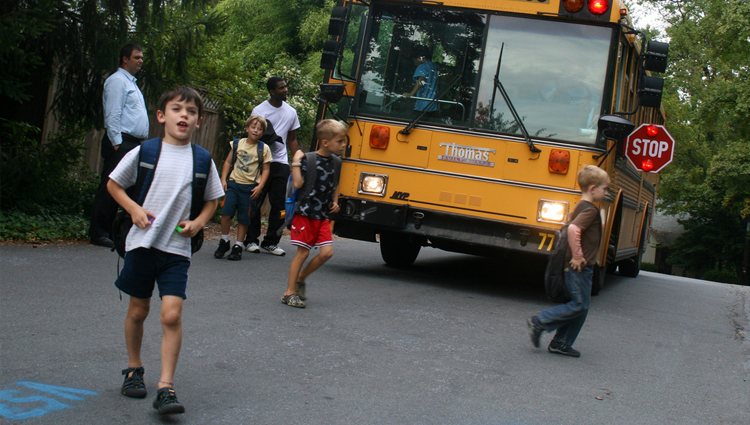CDC, Scientists: Keep Schools Open

(Inside Science) -- This spring, hundreds of schools followed the recommendations of public health officials and shut down preemptively to prevent the spread of the swine flu virus. But as the new school year begins and the first cases of swine flu appear in classrooms, the advice has changed. Schools are staying open.
"What we learned last spring is that shutting a school down sort of preemptively doesn't stop the virus from spreading," said Health and Human Services Secretary Kathleen Sebelius in a recent interview on NBC's Today Show.
Scientists who design the computer models used to assess the effects of school closing suggest that the strategy can slow the spread of disease, depending on the situation. But unless the new H1N1 virus changes its pattern, they said, the costs of shutting school doors are likely to outweigh the benefits.
Swine flu, which has now infected more than a million people nationwide, is unusual in that it tends to affect the young most severely. Just five percent of swine flu-related hospitalizations have occurred in adults over the age of 65, as compared to 60 percent for seasonal flu.
This has placed children and teenagers -- and school closings -- center stage in the discussion about how to best prepare for the flu season.
In this month's issue of the journal The Lancet Infectious Diseases, Simon Cauchemez of Imperial College in London reviewed the effects that school closings have had historically on the spread of disease -- from Hong Kong's response to severe acute respiratory syndrome in 2003 to links between school holidays and influenza in France.
The effectiveness of the strategy depended on the situation. A careful analysis of a 2008 influenza outbreak in Hong Kong found no benefit to schools being closed for two weeks. A two-week Israeli teacher strike in 2008, however, reduced the number of people diagnosed with respiratory tract and viral infections by 43 percent. The timing of the intervention, as well as the nature and severity of the virus strain, were all important factors.
After assessing data from H1N1 infections in May, the Centers for Disease Control and Prevention decided that the virus was less severe than initially thought to be and recommended against school closings. "Such measures bring significant cost -- such as interrupting student learning -- without a significant public health benefit," read the new CDC guidelines.
Cauchemez also cautions again school closings. "In the current context, we would not recommend prolonged school closure," he said. "We think that governments are completely right in being cautious [by not closing schools]."
The big issue, Cauchemez said, is that many models require children to be quarantined in their homes to get a benefit from school closings, which would impose significant economic burdens on parents and societies. A British study estimated that school closings would cost between 0.2 and 1.2 billion pounds (about $0.3 to $2 billion) per week in the U.K., as parents stayed home from work to take care of their children. Other studies argue that absenteeism would negatively impact the healthcare system, whose workers are disproportionately women likely to go home to care for their children.
These costs are likely to have the greatest impact on the poor, according to another study that looked at children who receive free meals at school and the economic hardships of lower-income single parents trying to care for their children.
If children are not quarantined, the benefits from school closings are less certain.
"The problem is what do you do with a kid once the school is closed ... where do they go, who do they mix with in their neighborhoods and their homes," said Ira Longini of the University of Washington in Seattle. His model assumes that students see their friends twice as often as they normally would outside of school, but he acknowledges that the evidence for this assumption is lacking.
If children do not comply with a quarantine request -- or if they spend more time with each other than the models assume -- the benefits of school closings would be reduced.
Other studies have also suggested that the benefits of school closings the longer they last, said Alessandro Vespignani of Indiana University in Bloomington. "Closing a school for two or three weeks may only slow down the spread of a virus by a week," he said.
The only reason to use short-term school closures would be if cases of influenza threatened to overwhelm the local healthcare, said Cauchemez.
Revised CDC guidelines in August put school closings back on the table, though cautiously so. They endorse closing only if a significant proportion of a school is already infected and suggest that preemptive closings may be recommended in the future, but only if the flu begins to spread quickly through the population at large.
"School and health officials should work closely to balance the risks of flu in their community with the disruption dismissals will cause in both education and the wider community," the CDC's guidelines read.
A report by the President's Advisors on Science and Technology released on August 7 echoed this prudent tone.
On the one hand, it recognized that school closings were very effective during the severe 1918 flu epidemic. "In cities that adopted early measures of 'social distancing,' such as canceling public gatherings and closing schools, the epidemic appeared to have spread more slowly and reached a lower peak incidence."
But it cautioned that the decision to close schools must be based on the severity of the disease, and that new H1N1 virus has not proved to be as dangerous as the 1918 pandemic. A plausible scenario suggested by the report placed the number of swine flu deaths at 30,000 to 90,000 deaths -- as compared to seasonal flu, which claims an average of 36,000 lives annually.
"Unless the severity of the 2009 H1N1 influenza increases markedly, it is unlikely that community mitigation on the scale envisioned for a more severe pandemic will be required," said the report.
Everyone agrees that closing down schools is only one of many strategies likely to be used against swine flu.
"The strategy that is going to be orders of magnitude more effective than school closing is vaccination," said Longini.
Computer models have been used to effectively justify the current strategy of prioritizing children and teenagers for the nation's limited supply of vaccines.
In June, scientists at the University of Warwick in the U.K. used their models to argue for selectively immunizing children -- rather than whole households. In July, the CDC's Advisory Committee on Immunization Practices took similar steps, recommending that the people between the ages of 6 months old through the age of 24 years old be prioritized for the country's limited supply of vaccines. A research paper published last week in the journal Science used a different kind of model to refine these age ranges, suggesting that the optimal age range to vaccinate would be 5 to 19 years.
And, as always, strategies that emphasize personal responsibility -- like handwashing or staying home if sick -- top the CDC's list of recommendations.

